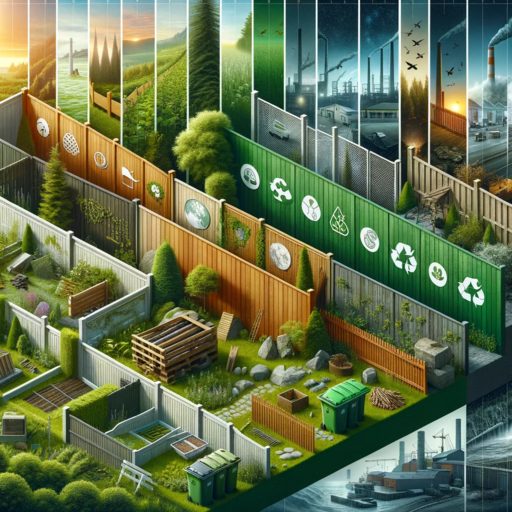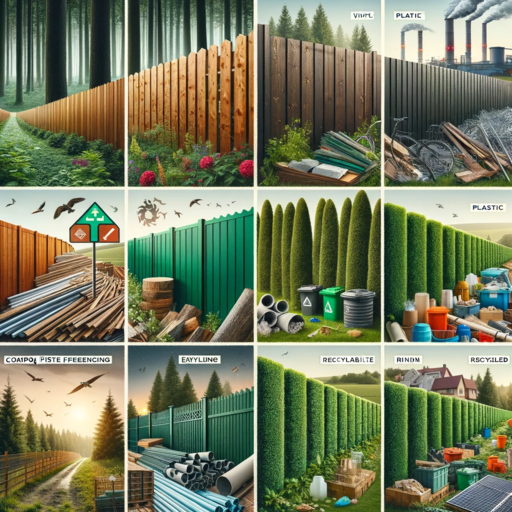Wood Fencing
Metal Fencing
Vinyl and Plastic Fencing
Composite Fencing
Eco-Friendly and Sustainable Natural Fencing Options
Conclusion
Understanding the Environmental Impact
When it comes to choosing materials for building fences, the environmental impact is an increasingly crucial factor. With the growing awareness of sustainability and ecological responsibility, homeowners and builders alike are seeking options that not only meet their practical needs but also align with their environmental values. This chapter delves into the various aspects of fencing materials and their ecological footprints, providing insights into how we can make more responsible choices.
Wood Fencing
Wood is a classic and popular choice for fencing due to its natural appearance, versatility, and relative affordability. However, its environmental impact is multifaceted, involving considerations of sustainability, sourcing, and treatment processes. This chapter explores these aspects, offering insights into how to make more eco-conscious choices when opting for wood fencing.
Sustainable Sourcing of Wood
- Certified Wood: Choosing wood certified by organizations like the Forest Stewardship Council (FSC) ensures it comes from responsibly managed forests.
- Local Sourcing: Opting for locally sourced wood can reduce transportation-related carbon emissions.
- Bamboo: As a fast-growing alternative, bamboo offers a sustainable and durable option.
When selecting wood for fencing, considering the source and certification can significantly impact its environmental footprint. Sustainable practices in forestry help maintain ecological balance and support biodiversity.
Impact of Treatment and Maintenance
| Aspect | Environmental Impact |
|---|---|
| Chemical Treatments | Use of chemicals like preservatives, insecticides, and fungicides can harm local ecosystems and wildlife. |
| Maintenance Requirements | Frequent need for treatments, staining, or sealing can increase the environmental cost over time. |
| End-of-Life Disposal | Treated wood can be difficult to recycle or repurpose, often ending up in landfills. |
Understanding the treatment processes and maintenance requirements of wood fencing is crucial. Opting for less toxic treatment methods and durable wood types can reduce environmental harm.
Alternatives to Traditional Wood Fencing
- Reclaimed Wood: Using reclaimed or recycled wood for fencing reduces waste and the demand for new lumber.
- Composite Materials: Some composites, blending wood with recycled plastics, offer durability with a reduced environmental footprint.
- Living Fences: Hedges or shrub barriers can provide a natural alternative to traditional fences, supporting local biodiversity.
In summary, while wood fencing remains a popular choice, its environmental impact varies based on sourcing, treatment, and maintenance practices. By considering sustainable sources, eco-friendlier treatments, and innovative alternatives, homeowners can significantly reduce the ecological footprint of their fencing choices.

Metal Fencing
Metal fencing, encompassing materials like steel, aluminum, and wrought iron, is valued for its durability, strength, and often minimal maintenance requirements. However, the environmental impact of metal fencing is a complex mix of factors, including production processes, recyclability, and longevity. This chapter aims to shed light on these aspects, guiding towards more eco-conscious decisions in metal fencing.
Production and Manufacturing Impact
- Energy Consumption: The production of metals like steel and aluminum is energy-intensive, contributing significantly to their carbon footprint.
- Emissions: Manufacturing processes can emit a range of pollutants and greenhouse gases, impacting air quality and contributing to climate change.
- Resource Extraction: The extraction of raw materials for metal production can have substantial environmental impacts, including habitat disruption and resource depletion.
Understanding the environmental cost of producing metal fencing is vital. Innovations in manufacturing and increased use of renewable energy sources can mitigate some of these impacts.
Recyclability and Sustainability
| Metal Type | Recyclability | Sustainability Notes |
|---|---|---|
| Steel | Highly recyclable | Recycling steel reduces the need for new raw materials and energy consumption. |
| Aluminum | Highly recyclable | Aluminum can be recycled multiple times with minimal loss of quality, reducing its overall environmental footprint. |
| Wrought Iron | Less commonly recycled | While durable, wrought iron recycling is less prevalent and more energy-intensive. |
The recyclability of metal fencing materials is a significant factor in their environmental assessment. Choosing materials with high recyclability can ensure a lower long-term ecological impact.
Longevity and Maintenance
- Durability: Metal fences often have a longer lifespan than other materials, reducing the frequency of replacement and associated environmental costs.
- Low Maintenance: Metals like aluminum require minimal maintenance, which translates into fewer chemicals and resources used over the fence's life.
- End-of-Life Considerations: At the end of its life, metal fencing can often be completely recycled, offering an eco-friendly disposal option.
In conclusion, while the production of metal fencing carries a significant environmental burden, its durability, recyclability, and low maintenance requirements contribute to a potentially lower overall ecological footprint over its lifespan. Informed choices in the type of metal and consideration of its full life cycle can make metal fencing a more environmentally responsible option.
Vinyl and Plastic Fencing
Vinyl and plastic fencing, known for their durability, ease of maintenance, and versatility, are popular choices in modern landscaping. However, their production and disposal raise significant environmental concerns. This chapter examines the ecological aspects of vinyl and plastic fencing, highlighting the importance of informed choices for those prioritizing environmental sustainability.
Production and Environmental Impact
- Resource Extraction: The production of vinyl and plastic fencing relies heavily on petroleum, a non-renewable resource.
- Emissions: Manufacturing processes of these materials can release harmful chemicals and greenhouse gases into the atmosphere.
- Energy Consumption: The production of synthetic fencing is energy-intensive, contributing to its carbon footprint.
It's crucial to understand the environmental cost of producing vinyl and plastic fencing. Even though these materials offer practical benefits, their ecological impact during production is significant.

Recyclability and End-of-Life Disposal
| Aspect | Environmental Impact |
|---|---|
| Recyclability | Vinyl and plastic fences are less likely to be recycled due to the complexity and cost of the process. |
| End-of-Life Disposal | Non-biodegradable nature leads to long-term environmental impact when disposed of in landfills. |
The recyclability and disposal of vinyl and plastic fencing are significant environmental concerns. The challenge of recycling these materials often leads to them ending up in landfills, where they do not degrade, posing long-term ecological issues.
Alternatives and Sustainable Options
- Recycled Plastic Fencing: Choosing fencing made from recycled plastics can help reduce waste and the demand for new raw materials.
- Eco-friendly Manufacturing: Some manufacturers are adopting more sustainable practices, such as reducing emissions and using recycled materials in production.
- Biodegradable Alternatives: Research into biodegradable plastics and other eco-friendlier materials offers potential future alternatives for environmentally conscious consumers.
While vinyl and plastic fencing have practical advantages, their environmental impact cannot be overlooked. Consumers and manufacturers alike have the responsibility to consider these impacts, exploring more sustainable practices and alternatives wherever possible. By doing so, it becomes possible to align the convenience of synthetic fencing with a commitment to environmental stewardship.
Composite Fencing
Composite fencing, a blend of wood fibers and plastic polymers, has emerged as a popular alternative to traditional fencing materials. It's appreciated for its durability, aesthetic appeal, and low maintenance needs. However, the environmental implications of composite fencing are nuanced, involving considerations of manufacturing, longevity, and end-of-life disposal. This chapter explores these factors to provide a comprehensive view of composite fencing's ecological footprint.
Manufacturing and Material Sources
- Use of Recycled Materials: Many composite fencing products incorporate recycled wood and plastic, reducing waste and the demand for new raw materials.
- Energy Consumption: The production process of composite materials can be energy-intensive, although often less so than completely synthetic materials.
- Emission of Greenhouse Gases: Manufacturing composite fencing can emit greenhouse gases, but advancements in production technology are seeking to minimize this impact.
Understanding the balance between the use of recycled materials and the environmental cost of production is key in assessing the ecological impact of composite fencing.
Longevity and Maintenance
| Aspect | Environmental Benefit |
|---|---|
| Longevity | Composite fencing tends to have a longer lifespan compared to traditional wood, reducing the frequency of replacement and associated environmental costs. |
| Maintenance | Requires less maintenance (e.g., no need for painting or staining), leading to lower use of chemicals and resources over its lifespan. |
The durability and low maintenance requirements of composite fencing contribute positively to its environmental assessment, offsetting some of the impacts from its production phase.
End-of-Life Considerations
- Recyclability: While composite materials can be more challenging to recycle than pure wood or plastic, efforts are being made to improve their recyclability at the end of their lifespan.
- Disposal Impact: The composite material's mix of wood and plastic can complicate its disposal, potentially leading to longer decomposition times in landfills compared to organic materials.
Composite fencing presents a mixed picture in terms of environmental impact. Its use of recycled materials and longevity are positive aspects, but these need to be weighed against the energy use in production and challenges in end-of-life disposal. As manufacturing technologies evolve, there is potential for further improvements in the environmental profile of composite fencing.
Eco-Friendly and Sustainable Natural Fencing Options
Exploring natural alternatives for fencing is not just a trend but a significant step towards sustainability. These options, ranging from living fences to the use of native plants, offer an environmentally friendly approach to delineating boundaries. This chapter focuses on various natural fencing alternatives, highlighting their ecological benefits and practical considerations.
Living Fences
- Hedges and Shrubs: Using dense hedges or shrubs as living fences promotes biodiversity and offers habitats for wildlife.
- Tree Lines: Rows of trees can act as effective barriers while also contributing to carbon sequestration.
- Edible Fences: Utilizing fruit-bearing shrubs or vines combines the functionality of fencing with the benefit of producing food.
Living fences are not only aesthetically pleasing but also contribute positively to the local ecosystem by supporting a variety of flora and fauna.
Sustainable Wood and Bamboo
| Material | Environmental Benefits |
|---|---|
| Sustainably Sourced Wood | Using wood from sustainably managed forests helps prevent deforestation and habitat loss. |
| Bamboo | Bamboo grows rapidly, absorbs carbon dioxide efficiently, and is a renewable resource. |
Opting for sustainable wood and bamboo offers a balance between traditional fencing materials and environmental responsibility.
Stone and Natural Barriers
- Stone Walls: Utilizing locally sourced stones for building fences reduces transportation emissions and blends seamlessly with the natural landscape.
- Earth Berms: Earth mounds or berms can be shaped to form natural barriers, minimizing the need for external materials.
Stone and natural barriers are durable, require minimal maintenance, and have a negligible carbon footprint compared to manufactured fencing materials.
In conclusion, natural fencing alternatives offer a range of eco-friendly solutions that not only serve their purpose but also enhance the local environment. By choosing these options, individuals can significantly reduce their environmental impact and contribute to a more sustainable future.
Conclusion
In this exploration of the environmental impact of various fencing materials, we've seen how each type has its own set of ecological implications. From the traditional wood and metal to modern composites and natural alternatives, the choice of fencing material can significantly influence both the local and global environment. This concluding chapter aims to encapsulate the key points from each material, offering a final perspective on making environmentally conscious fencing choices.
Key Takeaways
- Wood Fencing: Sustainable when sourced responsibly, but requires consideration of treatment chemicals and maintenance.
- Metal Fencing: Durable with high recyclability, yet its production is energy-intensive with notable emissions.
- Vinyl and Plastic Fencing: Low maintenance but poses challenges in recyclability and long-term environmental impact.
- Composite Fencing: Utilizes recycled materials and offers longevity, but faces challenges in production energy use and end-of-life recyclability.
- Natural Fencing Alternatives: The most eco-friendly options, supporting biodiversity and reducing carbon footprint.
As we conclude, it's evident that no fencing material is entirely without environmental impact. However, by considering factors such as sustainability, production processes, maintenance needs, and end-of-life disposal, we can make more informed choices that align with our environmental values.
Final Thoughts
Ultimately, the decision on which fencing material to use should be guided not only by aesthetic and functional preferences but also by a commitment to environmental stewardship. As consumers and homeowners, our choices can contribute to a more sustainable future. It is our responsibility to weigh these choices carefully, considering the long-term ecological impacts alongside our immediate needs.
This comprehensive review of fencing materials and their environmental impacts serves as a guide to help you make responsible and informed decisions. By choosing wisely, we can all play a part in preserving our planet for future generations.




